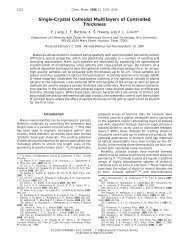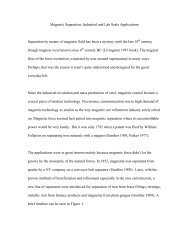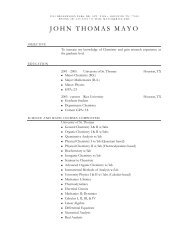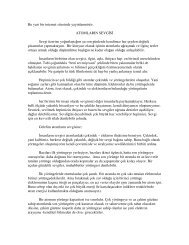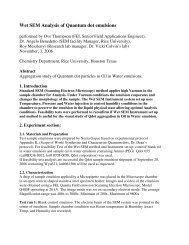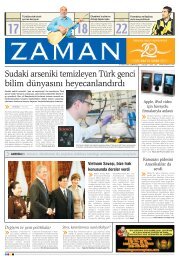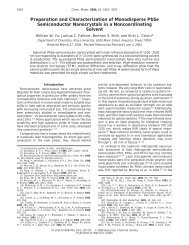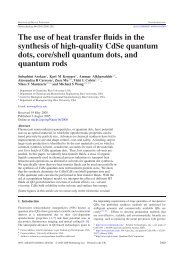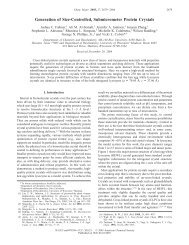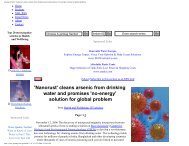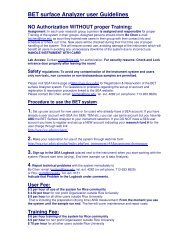Nano-C60 cytotoxicity is due to lipid peroxidation
Nano-C60 cytotoxicity is due to lipid peroxidation
Nano-C60 cytotoxicity is due to lipid peroxidation
Create successful ePaper yourself
Turn your PDF publications into a flip-book with our unique Google optimized e-Paper software.
7588<br />
<strong>cy<strong>to</strong><strong>to</strong>xicity</strong> of nano-<strong>C60</strong> and confirm the importance of<br />
oxidation.<br />
Water-soluble fullerene derivatives are most commonly<br />
formed by deliberate synthetic methodologies<br />
and typically have altered cage chem<strong>is</strong>try and high<br />
(4100 ppm) water solubility. In contrast, the nano-C 60<br />
colloid investigated here <strong>is</strong> only sparingly soluble; it <strong>is</strong><br />
produced by the addition of organic soluble <strong>C60</strong> <strong>to</strong> water<br />
[5–8]. The same substance <strong>is</strong> also found when solid <strong>C60</strong> <strong>is</strong><br />
stirred in tap water for 2 months [9]. Because of its ease<br />
of formation, and stability in water, nano-<strong>C60</strong> <strong>is</strong> likely <strong>to</strong><br />
be an important form of <strong>C60</strong> in natural aqueous systems.<br />
The full characterization of the nano-C 60 water<br />
suspension <strong>is</strong> publ<strong>is</strong>hed in two separate reports [4,10].<br />
Proof of the presence of <strong>C60</strong> in the aqueous suspension<br />
include electron diffraction via cryo-TEM, chroma<strong>to</strong>graphic<br />
profiles and signature spectroscopic peaks<br />
identify the presence of <strong>C60</strong> in the aqueous solution. In<br />
addition, microscopy images show the size, shape and<br />
crystallinity of the <strong>C60</strong> colloids. While the method of<br />
nano-C 60 preparation may leave intercalated THF, mass<br />
spectroscopy and liquid chroma<strong>to</strong>graphy prove that<br />
more than 90% by weight of the suspension <strong>is</strong> <strong>C60</strong>, i.e.<br />
o10% of the suspension <strong>is</strong> residual solvent. Viability<br />
controls confirm that th<strong>is</strong> residual solvent does not<br />
contribute <strong>to</strong> cell death or generation of ROS. The<br />
structural of the nano-<strong>C60</strong> colloid cons<strong>is</strong>ts of a pr<strong>is</strong>tine<br />
<strong>C60</strong> core (of 10–1000 <strong>C60</strong> molecules, depending on size of<br />
crystal) surrounded by a low derivatized C 60 layer that<br />
forces the aggregate <strong>to</strong> be m<strong>is</strong>cible in the aqueous phase.<br />
The extent of the derivatization <strong>is</strong> 3 groups or less,<br />
composed of either hydroxylated or oxidized fullerenes<br />
(confirmed by nuclear magnetic resonance and Fourier<br />
transform infrared spectroscopy). The negative surface<br />
charge of the aggregate <strong>is</strong> further evidence of a<br />
hydrophilic surface derivation. Because of th<strong>is</strong> low<br />
degree of derivatization, we cannot fully identify the<br />
exact chemical composition of these groups.<br />
Previous reports by Oberdorster suggest the brain and<br />
liver of largemouth bass produce changes in glutathione<br />
production once exposed <strong>to</strong> nano-<strong>C60</strong>. Therefore, we<br />
hypothesize that the human cell lines hDF, Human liver<br />
carcinoma cells (HepG2), and NHA might be affected<br />
by nano-<strong>C60</strong>. More specifically, within these cell lines,<br />
we concentrated on examining the effect of nano-C 60 on<br />
the membrane of the cell, since we previously reported<br />
that nano-<strong>C60</strong> produces oxygen radicals in water.<br />
2. Materials and methods<br />
All chemicals were purchased through Sigma Aldrich at<br />
highest purity unless otherw<strong>is</strong>e stated and experiments were<br />
performed minimally in triplicate. Data are presented as mean<br />
7 standard deviation, and a student’s t-test was used <strong>to</strong><br />
determine significance.<br />
ARTICLE IN PRESS<br />
C.M. Sayes et al. / Biomaterials 26 (2005) 7587–7595<br />
2.1. <strong>Nano</strong>-C 60 preparation<br />
C 60 was suspended in water using the method of Deguchi et<br />
al. [7] <strong>C60</strong> (99.5%, MER Corporation), was d<strong>is</strong>solved in<br />
tetrahydrofuran (THF, F<strong>is</strong>her Scientific) at a concentration of<br />
100 mg/L. The solution was sparged with nitrogen and stirred<br />
overnight in the dark. The solution was then filtered through a<br />
0.22 mm nylon filter (Osmonics, F<strong>is</strong>her Scientific). MilliQ water<br />
was added <strong>to</strong> an equal volume of C 60 in THF at a rate of 1 L/<br />
min. Th<strong>is</strong> solution was evaporated <strong>to</strong> eliminate the THF using<br />
a rotary evapora<strong>to</strong>r (Buchii). Mass spectroscopy of solvent<br />
after th<strong>is</strong> procedure finds no residual THF in solution. A 1 L<br />
mixture was evaporated <strong>to</strong> 450 mL, refilled <strong>to</strong> 550 mL with<br />
MilliQ water, and then again evaporated <strong>to</strong> 450 mL. The<br />
volume was adjusted <strong>to</strong> 550 mL again, and then evaporated <strong>to</strong><br />
500 mL. Th<strong>is</strong> final solution was s<strong>to</strong>red overnight and then<br />
filtered through a 0.22 mm nylon filter <strong>to</strong> yield a suspension of<br />
aggregated <strong>C60</strong> in water referred <strong>to</strong> as nano-<strong>C60</strong>. <strong>C60</strong>(OH)24<br />
was obtained from MER Corporation at 99.8% purity.<br />
2.2. Cy<strong>to</strong><strong>to</strong>xicity/viability<br />
Human dermal fibroblasts (HDF) (Cambrex) were cultured<br />
in Dulbecco’s Modification of Eagles Media (DMEM) with<br />
10% fetal bovine serum and 2 mM L-glutamine, 100 U/mL<br />
penicillin, and 1 mg/mL and strep<strong>to</strong>mycin. HepG2 (American<br />
Type Culture Collection) were cultured in minimal essential<br />
media (MEM) with 10% fetal bovine serum and 2 mM Lglutamine,<br />
100 U/mL penicillin, and 1 mg/mL and strep<strong>to</strong>mycin.<br />
Neuronal human astrocytes (NHA) (Cambrex) were<br />
cultured in Astrocyte Basal Medium (ABM TM ) derived from<br />
MCBB131 classical media with 10% fetal bovine serum and<br />
1.5% rhEGF, 2.5% insulin, 1% ascorbic acid, 1% gentamicin<br />
sulfate and amphotericin-B, and 10% L-glutamine. For all<br />
three cell types, passage numbers 2–10 were used in the<br />
experiments. 5 mL calcein AMand 20 mL ethidium homodimer<br />
(Molecular Probes) in 10 mL phosphate buffer solution were<br />
used <strong>to</strong> determine cell viability following 48 h exposure <strong>to</strong><br />
fullerenes. Fullerenes (nano-<strong>C60</strong>) suspended in ultrapure water<br />
and sterilized via filtration (0.22 mm) were added <strong>to</strong> cells,<br />
grown in 24 well plates, at concentration of 0.24, 2.4, 24, 240<br />
and 2400 ppb. For each experiment, the viability of untreated<br />
HDF, HepG2, and NHA cells, as well as cells treated with<br />
phosphate buffered saline (PBS) solution, was evaluated as<br />
well. Cell viability was evaluated via fluorescence microscopy<br />
(Ze<strong>is</strong>s Axiovert 135). The experiment was repeated six times.<br />
2.3. Lactate dehydrogenase release<br />
The release of lactate dehydrogenase (LDH) was also<br />
moni<strong>to</strong>red over the nano-C 60 concentration range described<br />
above. Cells (HDF, HepG2, NHA) were seeded in 24-well<br />
plates, exposed <strong>to</strong> nano-<strong>C60</strong>, and incubated for 48 h. After<br />
incubation, the cell media was transferred <strong>to</strong> 15 mL centrifugation<br />
tubes (<strong>to</strong>tal volume 4 mL) and were centrifuged at 300g<br />
for 4 min. The media was decanted and analyzed for LDH<br />
release as previously described [11,12]. Upon addition of assay<br />
solutions, the media was protected from the light for 30 min.<br />
During th<strong>is</strong> inoculation time, NAD <strong>is</strong> reduced <strong>to</strong> NADH using<br />
the LDH released in the medium. 400 mL of1N HCl was then



